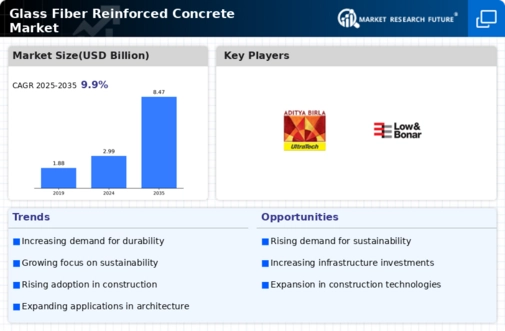Market Growth Projections
The Global Glass Fiber Reinforced Concrete Market Industry is poised for substantial growth in the coming years. Projections indicate that the market will reach 2.99 USD Billion in 2024 and is expected to expand significantly to 8.47 USD Billion by 2035. This growth trajectory suggests a robust compound annual growth rate (CAGR) of 9.93% from 2025 to 2035. Such figures reflect the increasing adoption of GFRC across various sectors, driven by its unique properties and benefits. The anticipated growth underscores the material's potential to reshape the construction landscape globally.
Versatility in Architectural Applications
The versatility of glass fiber reinforced concrete in architectural applications is a key driver for the Global Glass Fiber Reinforced Concrete Market Industry. GFRC can be molded into various shapes and finishes, allowing architects to explore innovative designs without compromising structural integrity. Its lightweight nature facilitates easier installation, making it a preferred choice for decorative elements, cladding, and facades. This adaptability enhances its appeal in both residential and commercial projects, contributing to increased demand. As architects continue to push the boundaries of design, the market for GFRC is expected to expand, reflecting its growing importance in contemporary architecture.
Technological Advancements in Concrete Production
Technological innovations in concrete production are significantly influencing the Global Glass Fiber Reinforced Concrete Market Industry. Advanced mixing techniques and the incorporation of high-performance fibers enhance the mechanical properties of GFRC, making it more appealing for various applications. For example, the use of automated manufacturing processes ensures consistent quality and reduces production costs. These advancements not only improve the performance of GFRC but also expand its applicability in architectural designs and infrastructure projects. As a result, the market is anticipated to grow at a CAGR of 9.93% from 2025 to 2035, further solidifying its position in the construction sector.
Rising Demand for Sustainable Construction Materials
The Global Glass Fiber Reinforced Concrete Market Industry is experiencing a notable shift towards sustainable construction practices. As environmental concerns gain prominence, builders and architects increasingly favor materials that minimize ecological impact. Glass fiber reinforced concrete (GFRC) offers enhanced durability and reduced weight, which contributes to lower carbon footprints. For instance, GFRC can be utilized in facades, reducing the need for heavy structural support. This trend is projected to drive the market's growth, with the industry expected to reach 2.99 USD Billion in 2024, reflecting a growing preference for eco-friendly construction solutions.
Increasing Urbanization and Infrastructure Development
The rapid pace of urbanization and infrastructure development is a significant driver for the Global Glass Fiber Reinforced Concrete Market Industry. As cities expand, there is a growing need for durable and aesthetically pleasing construction materials. GFRC is particularly suited for urban environments due to its lightweight nature and versatility in design. It is increasingly used in high-rise buildings, bridges, and public spaces, enhancing both functionality and visual appeal. This trend is expected to contribute to the market's growth, with projections indicating a rise to 8.47 USD Billion by 2035, underscoring the material's relevance in modern construction.
Government Initiatives Supporting Innovative Construction Materials
Government initiatives aimed at promoting innovative construction materials are playing a crucial role in the Global Glass Fiber Reinforced Concrete Market Industry. Various countries are implementing policies that encourage the use of advanced materials to improve building efficiency and sustainability. For instance, incentives for using GFRC in public projects can lead to increased adoption among contractors and developers. These initiatives not only enhance the market's visibility but also foster research and development in GFRC applications. Consequently, this supportive regulatory environment is likely to propel market growth and adoption in the coming years.













Leave a Comment